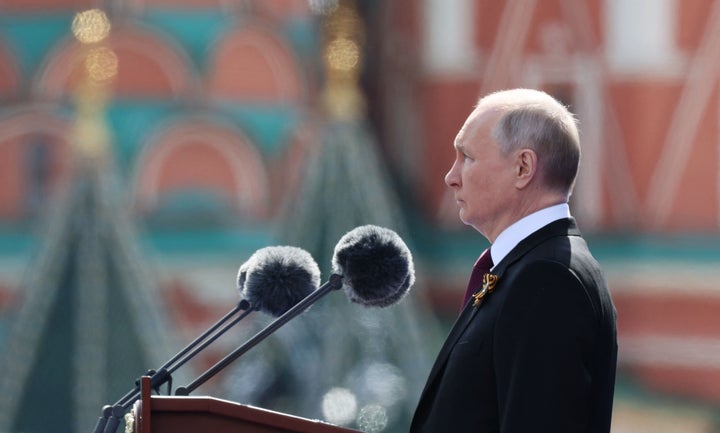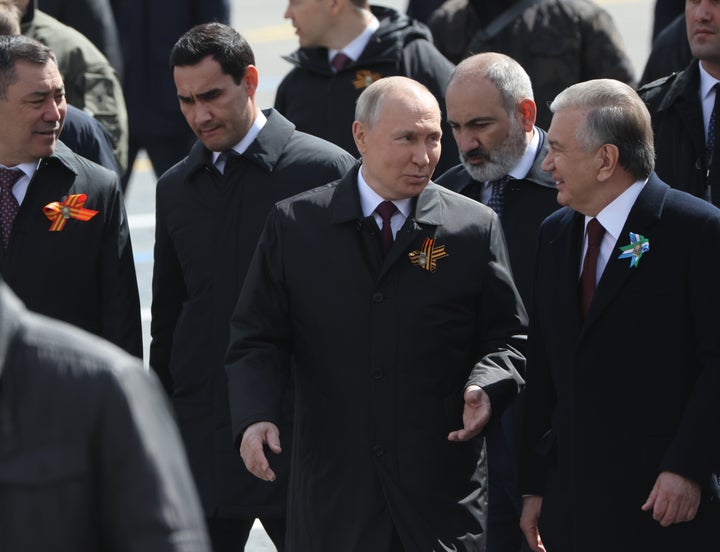
Victory Day is always a big day in Russia – but this year was particularly noteworthy, especially as the Ukraine war rages on.
The annual celebration has become a way to bolster nationalism across Russia, even though this year it was surrounded by anxieties after a spate of mysterious attacks on the country and a stagnant performance on the battlefield.
But surprisingly, six leaders from different countries attended the extravagant celebrations in Moscow on Tuesday.
Here’s what that tells us about the war and Russia’s regional power.
What is Victory Day?
This is an annual occasion in Russia which honours the Soviet Union’s defeat of Nazi Germany back in 1945.
It’s especially important to the country considering the Soviet Union lost around 27 million citizens in World War 2.
Victory Day is also accompanied by a huge display of military prowess through Red Square in Moscow, with celebrations across the country.
Its importance within Russia has grown since the Kremlin ordered the invasion of Ukraine last year, because Putin has been trying to justify the decision by comparing it to the Soviets’ fight against the Nazis. He has repeatedly made baseless allegations that Nazis operate in the Kyiv government.
Who attended?
Six leaders of former Soviet states – who are all part of the Commonwealth of Independent States, CIS – attended the parade:
1. Belarus’s president Alexander Lukashenko
2. Kazakhstan’s president Kassym-Jomart Tokayev
3. Armenia’s prime minister Nikol Pashinyan
4. Tajikistan’s president Emomali Rahmon
5. Uzbekistan’s president Shavkat Mirziyoyev
6. Kyrgyzstan’s president Sadyr Japarov
The event was not attended by any representatives from any major economies or Ukrainians.
Why is this a big deal?
This is the first time Putin has been able to persuade this many significant politicians from other countries to join him in the Red Square since 2020.
In 2021, only one leader (president of Tajikstan) was able to attend due to Covid restrictions, and in 2022, Putin stood alone, presumably due to the backlash of the war.
However, the attendance of five more regional leaders boosts Putin’s regional power.
Considering Putin has been mostly shunned on the international stage over his decision to invade Ukraine, alliances are crucial to maintaining his position.

Why did they attend?
Russia analyst Kateryna Stepanenko from the Institute for the Study of War, told HuffPost UK: “Putin likely invited the CIS leaders to showcase that he is not isolated and still has allies or use the Victory Day event to rally up CIS partners, many of which have sought to reduce their reliance on the Kremlin since the start of the full-scale invasion.
“Putin may be also attempting to showcase to his domestic constituencies that he still has everything under control ahead of the planned Ukrainian counteroffensive and to deflect from the smaller-sized parade this year.”
She also suggested that Kremlin’s claim last year that Putin didn’t invite any foreign leaders because it was not an “anniversary date” was an “absurd excuse” for the president to “downplay” the effects of the war in Ukraine.
The spokesperson for Ukrainian president Volodymyr Zelenskyy expressed a similar sentiment on Twitter.
Iuliia Mendel claimed they were present because some are “too dependent” on Russia, or “too weak militarily”.
She also suggested, “some want to use this opportunity for important negotiations” or that they may see ignoring the parade as “disrespectful to their own constituency”.
Why was Russia feeling nervous about Victory Day?
There’s been a spate of attacks on the country over the last few weeks, with oil depots and freight trains sabotaged amid a string of drone assaults.
Ukraine has denied any responsibility in these attacks, but Kremlin spokesman Dmitry Peskov has suggested otherwise.
He claimed: “We are of course aware that the Kyiv regime, which is behind a number of such attacks, terrorist acts, plans to continue its campaign.
“All our special services are doing everything possible to ensure security.”
Authorities were so wary that the Victory Day parade in Red Square was not open to the public this year .
Victory Day celebrations were actually cancelled in some parts of Russia near the Ukrainian border, over fears that they be targeted in the highly-anticipated Kyiv counteroffensive.
As BBC Russia editor Steve Rosenberg claimed: “It was a very different Victory Day parade from the one we’re used to seeing on Red Square.”
He said that fewer soldiers were present (8,000 compared to 11,000 in 2022), with less military hardware, no modern tanks, no military flypast, and a shorter parade altogether.
What about the speech?
Putin’s Victory Day speech was slightly different this year as well, as it focused on the strength of the Russian soldiers rather than focusing on ideas which promote the war.
The president claiming that “there is nothing more important” than Russia troops and their fight on their frontline, adding that the whole country is united in supporting its “heroes”.
Putin also made his usual allegations about the West, claiming that “their goal is nothing else but to see the fall of our country”, and presented Russia as the real victim of the West’s “Russophobia” – much like last year’s.
What about Putin’s ribbon?
Putin was wearing a black and orange striped ribbon during the Victory Day parade, as were many other attendees.
These are St George’s ribbons and meant to honour those who fell in World War 2. However, it has become a deeply divisive symbol over the years and is now associated with Russian nationalism.
Putin made it illegal to desecrate the symbol back in December. Since 2017, Ukraine has fined anyone wearing the ribbon in public.
What has Ukraine been doing?
Meanwhile, Ukraine has changed the official dates of events marking the end of the WW2 to move itself away from Russia.
Instead, Ukraine celebrates Victory Day on May 8, and May 9 has become Europe Day (although Ukraine’s parliament still needs to approve the change).
EU chief Ursula von der Leyen is visiting Kyiv in honour of Europe Day.
Meanwhile, Russia launched more air strikes on Ukraine hours before its Victory Day celebrations began, although Kyiv said it shot down 23 out of 25 cruise missiles.
